On November 19, the California Occupational Safety and Health Standards Board will consider an emergency standard for coronavirus disease 2019 (COVID-19) prevention, which would require employers to provide face coverings and COVID-19 testing at no cost to their employees. COVID-19 is a respiratory disease caused by the SARS-CoV-2 virus.
California would become the fourth state, following Virginia, Michigan, and Oregon, to establish an emergency COVID-19 rule if the board approves the proposed rule.
Labor unions and members of Congress have called on Secretary of Labor Eugene Scalia to adopt a federal emergency temporary standard (ETS) without success.
The proposed rule being considered by the state board would contain provisions for prevention in the workplace and in employer-provided housing and transportation, as well as a rule for investigating and handling outbreaks. Central to the rules would be requirements to identify and evaluate hazards and develop a written COVID-19 prevention program.
California employers would be required to develop and implement a process for screening employees and responding to COVID-19 symptoms. Employers also would have to evaluate how to maximize the quantity of outdoor air and whether it is possible to increase filtration efficiency to the highest level compatible with their existing ventilation systems. They would need to review all orders and guidance from state and local public health departments. The new rules would require employers to evaluate their existing COVID-19 measures and determine if there is a need for additional or new control measures.
California employers would be required to provide face coverings and ensure they are worn by employees over the nose and mouth when indoors and outdoors and less than 6 feet away from others. Employees who cannot wear a face covering due to a disability or medical condition must wear a face shield with a drape on the bottom and maintain a 6-foot distance from others. Neither a face shield nor COVID-19 testing would be an acceptable alternative to face coverings.
Engineering and administrative controls and personal protective equipment (PPE) required under the proposed rule would include the installation of partitions where physical distancing cannot be maintained; increased ventilation; cleaning and disinfecting; and evaluating the additional use of goggles, face shields, and gloves in preventing COVID-19 exposures. Any use of eye or respiratory protection must conform to the state’s existing PPE regulations.
The proposed rules would include requirements to record and report COVID-19 cases or fatalities. The written COVID-19 prevention program would have to be made available to employees, their representatives, and officials of the Division of Occupational Safety and Health (Cal/OSHA).
A negative COVID-19 test would not be required for an employee to return to work, but return-to-work criteria would include:
- At least 10 days since COVID-19 symptoms first appeared, an improvement in symptoms, and at least 24 hours since a fever of 100.4 or higher has resolved without the use of fever-reducing medications for employees with COVID-19 symptoms; or
- A minimum of 10 days since the date of specimen collection of their first positive COVID-19 test for employees who tested positive but never developed COVID-19 symptoms.
Any insulation or quarantine ordered by a state or local public health official would supersede the return-to-work criteria.
Rules for multiple infections or a COVID-19 outbreak would apply if an outbreak has been identified by a local health department or there are three or more COVID-19 cases in an exposed workplace in a 14-day period. Employers would then need to investigate new or unabated COVID-19 hazards and reevaluate the policies and practices of their written prevention program.
In the event of a major COVID-19 outbreak—20 or more cases in a 30-day period—employers would need to provide twice-a-week testing and reevaluate the need for respiratory protection and take steps to improve indoor air quality, including:
- Filtering recirculated air in buildings or structures with mechanical ventilation with Minimum Efficiency Reporting Value (MERV)-13 or higher-efficiency filters, if compatible with the ventilation system;
- Using filters with the highest-compatible filtering efficiency, if MERV-13 or higher filters are not compatible with the ventilation system; and
- Evaluating whether portable or mounted high efficiency particulate air (HEPA) filtration units, or other air cleaning systems, would reduce the risk of transmission and implementing their use to the degree feasible.

